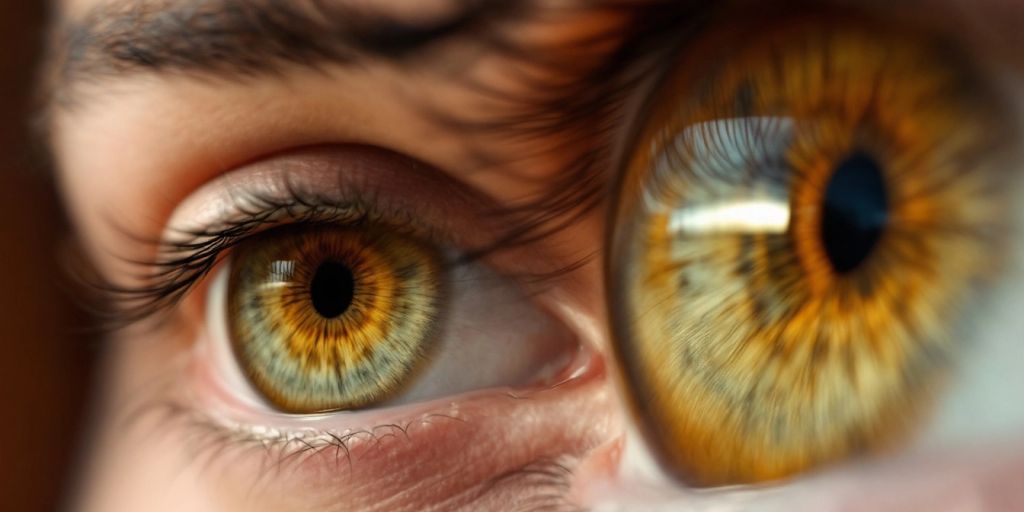In this article, we examine the question of whether brown eyes can be transformed into hazel eyes. There are many factors that influence eye color, from genetic aspects to age and lighting conditions. We will also look at the differences between brown and hazel eyes and clarify some common myths.
Key Findings
- Brown eyes are the most common worldwide.
- Hazel eyes show a mix of green, brown, and sometimes golden hues.
- Eye color is primarily determined by genetic factors but can vary slightly due to age or certain medical conditions.
- Environmental factors like light can affect the perception of eye color but do not lead to actual color changes.
- Many myths about the changeability of eye color are largely unfounded.
Can Brown Eyes Become Hazel?
The question of whether brown eyes can become hazel eyes is complex. Typically, eye color is genetically determined and remains constant throughout life. However, there are some factors that can cause brown eyes to appear hazel in certain situations.
Genetic Factors and Inheritance
Eye color is primarily determined by genes. Brown eyes have a high melanin content, which makes them darker. Hazel eyes, on the other hand, are a mix of brown, green, and gold. These color variations are genetically determined and can vary in different families.
Influence of Age and Health
As people age, their eye colors can change slightly. Often, they become lighter, which can cause brown eyes to take on a hazel shimmer. Certain health conditions or medications can also influence eye color. Here are some examples:
- Age-related changes
- Medical treatments
- Hormonal changes
Lighting Conditions and Perception
Light plays a crucial role in the perception of eye color. Under bright light or certain lighting conditions, brown eyes can take on a hazel hue. This occurs due to the reflection and scattering of light.
It is important to note that the actual eye color does not change, only the perception of it.
In summary, brown eyes can give a hazel impression in certain situations, such as lighting conditions or aging, but the genetic basis of eye color remains unchanged.
Differences Between Brown and Hazel Eyes
Color Composition and Pigmentation
Brown and hazel eyes differ in their color composition. While brown eyes have a uniform brown color, hazel eyes are a mix of various pigments, including brown, amber, and even green. This combination gives hazel eyes a special depth and variation.
Genetic Diversity and Rarity
Brown eyes are the most common eye color worldwide, indicating strong genetic inheritance. In contrast, hazel eyes are rarer and show greater genetic diversity. These differences in frequency and genetic basis make the two eye colors unique.
Perception in Different Lighting Conditions
Another important difference is how the two eye colors are perceived under different lighting conditions. Hazel eyes can change their color depending on the light, while brown eyes generally appear more stable. These color variations can be fascinating and influence the perception of eye color.
The diversity of eye colors showcases the beauty and complexity of human genetics.
In summary, the differences between brown and hazel eyes lie not only in color but also in genetic basis and perception. These differences contribute to the fascination and appeal of both eye colors.
The Role of Genetics in Eye Color
Genetics plays a crucial role in determining eye color. Human eye color ranges from the darkest browns to the lightest blues and is the result of complex genetic interactions.
Main Genes That Determine Eye Color
There are several genes that influence eye color. The most important are:
- HERC2: This gene acts like a switch that turns the OCA2 gene on or off.
- OCA2: Responsible for the production of melanin, the pigment that determines eye color.
- Other Genes: There are many other genes that contribute to the variation of eye color.
Inheritance Patterns and Genetic Diversity
Eye color is inherited from the genes of the parents. Here are some common inheritance patterns:
- Two brown-eyed parents can have children with brown or even green eyes.
- One parent with blue eyes and the other with brown eyes can lead to unpredictable results.
- Genetic variations can lead to surprising eye colors that do not meet expectations.
Influence of Melanin on Eye Color
Melanin is key to eye color. Higher concentrations of melanin generally lead to darker eye colors. Brown eyes have a lot of melanin, while lighter eye colors like blue or green contain less melanin.
| Eye Color | Melanin Concentration |
|---|---|
| Brown | High |
| Green | Medium |
| Blue | Low |
The genetic basis of eye color is complex, and melanin plays a central role in determining eye color.
In summary, eye color is the result of a variety of genetic factors working together to create the unique color palette we see in humans.
How Light Affects Eye Color

Physical Principles of Light Scattering
Light has a significant impact on how we perceive the color of our eyes. The scattering of light can cause brown eyes in certain lighting conditions to appear hazel or even greenish. This occurs due to an effect called Rayleigh scattering, where shorter light waves are scattered and the longer waves, which appear warmer, remain.
Daily Lighting Conditions and Their Effects
Eye color can vary depending on lighting conditions. Here are some examples:
- Bright sunlight: Brown eyes can appear lighter and warmer.
- Dusk: Eye color may appear darker.
- Artificial light: Under certain lamps, brown eyes can show greenish tones.
Why Eye Colors Look Different in Photos
In photos, eye color can often look different than in reality. This is due to:
- Flash: Can overexpose colors.
- Filters: Many cameras use filters that alter color perception.
- Background: Colors in the background can influence the perception of eye color.
Light plays a crucial role in the perception of eye color. It is important to understand that the actual color of the iris is not always the color we see.
Health Conditions That Can Change Eye Color
Medical Conditions and Treatments
There are various health conditions that can influence eye color. A sudden change in color can indicate a medical problem. Here are some common causes:
- Eye injuries: Injuries can damage the iris and change eye color.
- Horner’s syndrome: This rare condition can affect the pupils and iris, leading to a change in eye color.
- Iridocorneal endothelial syndrome (ICE): This condition can move cells from the cornea to the iris, affecting eye color.
Influence of Medications on Eye Color
Some medications can also change eye color. Here are examples:
- Medications for glaucoma: These can affect the iris and change its color.
- Hormonal treatments: Hormonal changes can influence melanin production and thus eye color.
- Long-term medications: Some medications can cause permanent color changes.
When to See a Doctor
It is important to see a doctor if:
- You notice a sudden change in color.
- Your eyes hurt or feel different.
- You have other symptoms like blurred vision or light sensitivity.
A sudden change in eye color should always be taken seriously, as it can indicate serious health problems.
Myths and Facts About Eye Colors
Common Misunderstandings About Eye Colors
There are many misunderstandings about eye colors, especially regarding their changeability. Here are some common myths:
- Eye color changes with mood: While emotions can affect pupil size, iris color does not change.
- Diet can change eye color: There is no scientific evidence supporting this claim.
- Eye color is only genetically determined: In fact, up to 16 genes play a role in determining eye color.
Scientific Explanations and Evidence
The color of our eyes is primarily determined by genetics. The amount and distribution of melanin, the pigment that gives our eyes their color, is crucial. Here are some key points:
- Melanin: Brown eyes have more melanin than lighter colors.
- Genetic diversity: Eye color can be influenced by grandparents, leading to unexpected results.
- Lighting conditions: The perception of eye color can change depending on the light.
Why Eye Color Does Not Change with Mood
It is important to understand that eye color is not simply influenced by emotional states. The iris remains constant in color, even when the pupils dilate or constrict.
Eye color is a fascinating feature of human diversity, determined by complex genetic factors.
In summary, many myths about eye colors exist, often based on misunderstandings or insufficient information. It is important to distinguish between actual changes in eye color and the perception of that color.
The Unique Features of Hazel Eyes

Hazel eyes are a fascinating eye color characterized by their unique color diversity. They combine various tones that can vary depending on lighting conditions.
Color Variations and Complexity
- Color composition: Hazel eyes consist of a mix of brown, green, and sometimes golden or copper tones.
- Light dependence: The color can change under different lighting conditions, giving them a special depth.
- Uniqueness: Each person has an individual combination of colors that makes their eyes unique.
Genetic Backgrounds and Distribution
- Genetic prerequisites: The emergence of hazel eyes depends on certain genes, particularly OCA2 and HERC2, which regulate melanin production.
- Frequency: Only about 5% of people worldwide have this eye color, making it a rare and sought-after trait.
- Distribution: Hazel eyes are most commonly found in people of European descent.
Perception and Aesthetic Appeal
- Aesthetics: The combination of different colors makes hazel eyes particularly appealing and attractive.
- Cultural significance: In many cultures, hazel eyes are seen as a sign of uniqueness and beauty.
- Romantic representations: This eye color is often romanticized in literature and media, contributing to its allure.
Hazel eyes are not only rare but also a fascinating example of the diversity of human genetics and the beauty it brings.
Brown Eyes: Frequency and Significance
Brown eyes are the most common eye color worldwide. They are not only widespread but also present in many different shades.
Global Distribution and Genetic Factors
- Brown eyes are particularly common in:
- Asia
- Africa
- Parts of South America
- In these regions, genetic factors are crucial for eye color.
Protective Functions of Melanin
- Melanin in brown eyes provides:
- Protection from UV rays
- Reduced risk of eye diseases such as cataracts
Aesthetic and Cultural Significance
- In many cultures, brown eyes are seen as:
- warm and inviting
- mysterious and profound
- attractive
Brown eyes are not only common but also a fascinating example of genetic diversity and adaptation to different environments.
Advantages and Disadvantages of Brown and Hazel Eyes
Health Benefits and Risks
- Brown eyes often have a higher melanin content, which protects them from certain eye diseases.
- People with brown eyes tend to be less susceptible to macular degeneration and eye cancer.
- In contrast, brown eyes may have a higher risk of cataracts.
Aesthetic Considerations
- Hazel eyes are rarer and are often perceived as particularly attractive.
- The color variations in hazel eyes can appear differently depending on lighting conditions, giving them a special appeal.
- Brown eyes are the most common eye color worldwide, making them less unique.
Influence on Light Sensitivity
- People with brown eyes often have better adaptation to bright light, making it easier to squint in sunlight.
- Hazel eyes may respond more quickly to dark lighting conditions, allowing for faster adaptation.
The differences between brown and hazel eyes are not only aesthetic but also health-related. Brown eyes often provide more protection, while hazel eyes impress with their diversity and rarity.
How Eye Colors Can Change Over Time
Age-Related Changes in Eye Color
Eye color can change over time, especially in children. Most babies are born with a bluish or grayish tint that can change in the first few years of life. Typically, eye color stabilizes between the 3rd and 9th month. In adults, however, significant changes are rare.
Influence of Environmental Factors
Environmental factors such as lighting conditions can influence the perception of eye color. For example:
- Bright lighting conditions can make the eyes appear lighter.
- Dark environments can make the eye color appear darker.
- Makeup can also enhance the tones of the eyes.
Rare Genetic Mutations
In some cases, genetic mutations can lead to changes in eye color. However, these are rare and often associated with other health issues.
It is important to see a doctor for sudden changes in eye color, as this can indicate health problems.
In summary, eye color can change over time, but most changes are minor and often influenced by external factors. However, caution should be exercised with significant changes, and a professional should be consulted.
Why Hazel Eyes Are Considered Rare

Hazel eyes are a rare and fascinating eye color that represents a mix of different hues. This eye color is not only beautiful but also unique, as it can change its color depending on lighting conditions. Here are some reasons why hazel eyes are considered rare:
Genetic Prerequisites for Hazel Eyes
- Genetic factors: The emergence of hazel eyes depends on certain genes, particularly the OCA2 and HERC2 genes.
- Inheritance: This eye color is common among people of European descent, explaining its rarity in other populations.
- Race and Ethnicity: Only about 5% of the world’s population has hazel eyes, making it a special genetic variation.
Distribution in Different Populations
- Frequency: Hazel eyes are more common in certain regions, such as Europe, while they are rarer in other parts of the world.
- Cultural perception: In many cultures, hazel eyes are considered particularly attractive and mysterious, contributing to their popularity.
- Uniqueness: The combination of brown, green, and gold makes this eye color particularly appealing and unique.
Cultural and Literary Representation
- Romanticization: Hazel eyes are often romanticized in literature and media, enhancing their allure.
- Aesthetic appeal: The variety of hues and the ability to change depending on light make them a fascinating subject in art and culture.
Hazel eyes are not only rare but also a fascinating example of the diversity of human genetics and the beauty it brings.
Conclusion
In summary, eye color depends on various factors, with genetic influences playing a central role. While it is rare for brown eyes to completely transform into hazel eyes, they can take on a hazel-like hue under certain lighting conditions. Age-related changes and certain medical conditions can also influence the perception of eye color. It is important to debunk myths about eye colors and understand that actual changes in eye color are generally rare. Ultimately, the diversity of eye colors remains a fascinating topic that reflects the beauty and complexity of human genetics.
Frequently Asked Questions
Can brown eyes really become hazel?
Brown eyes can appear hazel in certain situations like lighting conditions, but a permanent change is rare.
What influences eye color?
Eye color is primarily determined by genes but can also be influenced by age, health, and lighting conditions.
Why are there different shades of brown?
Brown eyes can come in various shades, from light brown to dark brown, depending on the amount of melanin.
What are hazel eyes?
Hazel eyes are a mix of brown, green, and sometimes gold, and they can change color depending on light.
Can eye color change over time?
Yes, eye color can change slightly with age, often becoming lighter, but a change from brown to hazel is rare.
Are there health conditions that influence eye color?
Yes, certain medical conditions or treatments can influence eye color, such as some medications for glaucoma.
Are hazel eyes rare?
Yes, hazel eyes are considered rarer than brown eyes and are often found in people of European descent.
Can emotions influence eye color?
Emotions can change pupil size, which can affect the perception of eye color, but they do not change the iris color itself.







